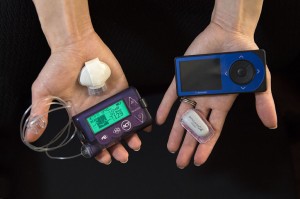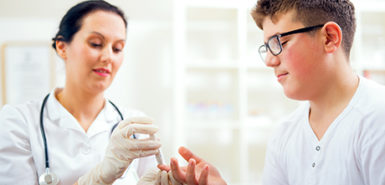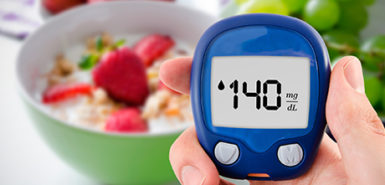
One of the most serious consequences of improperly treated type 1 diabetes is a condition known as diabetic ketoacidosis.
This condition can be dangerous, said Gregory Deines, DO, diabetologist and division chief of Diabetes & Endocrinology at Spectrum Health Medical Group.
Symptoms include nausea, vomiting, abdominal pain and weakness, and at the extreme, coma or even death.
Diabetes happens when cells in the pancreas lose the ability to produce insulin. A diagnosis of type 1 diabetes means that insulin, necessary for processing blood sugar into energy, isn’t being generated at all.
A different form of diabetes, type 2, begins when our body’s insulin production is too low to control blood sugar levels and the body tissues are unable to use the small amount of insulin efficiently.
Symptoms for either type—increased thirst, urination or hunger, tiredness, blurry vision, a tingling in the hands or feet—can appear suddenly.
The main reason for diabetic ketoacidosis is straightforward: a significant, unnoticed decline in the body’s insulin level that generates those severe symptoms. But learning how to use the correct dose of insulin can be difficult.
Ketoacidosis is treatable
“Some patients find out they have type 1 diabetes after experiencing DKA,” said Kellie Antinori-Lent, a spokeswoman for the American Association of Diabetes Educators.
But even those who know they have type 1 diabetes are at risk if they consistently take less insulin than needed, or skip some doses of their long-acting insulin, Dr. Deines explained.
Fortunately, though, diabetic ketoacidosis is a treatable condition, said Antinori-Lent—and, even better, it’s preventable.
“The key is being aware of the signs of high blood sugars,” she said. “When you’re aware of the signs and symptoms, you can act so that this doesn’t progress to DKA.”
The warning sign for this illness is a significant rise in blood glucose. Diabetes patients with rising blood sugar and low insulin, plus increased thirst and increased urinating, are getting an alert. A fruity smell on the breath is another warning sign. Not taking care of these symptoms will make them worse.
“In most cases, people develop ketoacidosis because they completely run out of insulin,” Antinori-Lent said.
A lack of insulin means that glucose can’t move from the blood into the body’s cells. The body then begins breaking down fat and muscle in order to get its needed glucose. The result is severe dehydration and dangerous shifts in potassium levels, causing abdominal pain, vomiting, weakness, breathing difficulties and even unconsciousness. In severe cases, diabetic ketoacidosis can be fatal.
But, Antinori-Lent added quickly, helpful steps can be taken far in advance of calling an ambulance.
She offered two pieces of advice:
1. Check your blood sugar regularly.
This is especially true if you have some of the symptoms mentioned earlier.
“If your readings are high, you must do something about it,” Antinori-Lent said. “Let your health care provider know.”
Responding quickly to high blood glucose levels can almost always prevent ketoacidosis, she said, but having a high glucose level and not responding is “like seeing that your gas tank is almost empty, but then not getting more gas.”
People with type 1 diabetes, who are most at risk for developing diabetic ketoacidosis, should test their urine for ketones if their glucose level rises above 300 mg/dl (milligrams per deciliter). Over-the-counter testing kits are readily available. One glucose monitor, the Precision Xtra, can simultaneously test glucose and ketone levels.
People with type 2 diabetes don’t usually develop this condition, although a severe illness during which the body’s stress hormones kick in, such as a cardiovascular problem, might generate ketoacidosis. And Dr. Deines added that type 2 patients who aren’t careful with their blood sugar can run the risk of other serious conditions. In some cases very high blood sugar can result in life-threatening illness.
2. Get educated—schedule an appointment with a diabetes educator to learn more about caring for your diabetes, including how to prevent ketoacidosis.
Spectrum Health offers individual counseling and group sessions.
“Education is power, and is the first step in making healthy choices,” Antinori-Lent said.
Caught early, people at risk for developing ketoacidosis can—with the help of their health care professional team—adjust their insulin dose and increase their fluid intake ahead of any serious problems.
The good news about ketoacidosis is that the U.S. Centers for Disease Control and Prevention has reported a steady decline in the number of ketoacidosis hospital admissions and deaths over the last decade or so. This is partly because of better care and also because of better-informed patients.
To ensure that those ketoacidosis statistics continue to improve, it remains important to get the message out, Antinori-Lent said.
A 2012 CDC study found that diabetes self-education programs are severely underused—less than 7 percent of people with diagnosed diabetes reported that they participate in education training to manage their condition.
Diabetes is like anything else in life, Antinori-Lent summarized.
“Your garden, your house, your relationships—the more effort you put into caring for them, the better they will be,” she said.
 /a>
/a>
 /a>
/a>
 /a>
/a>